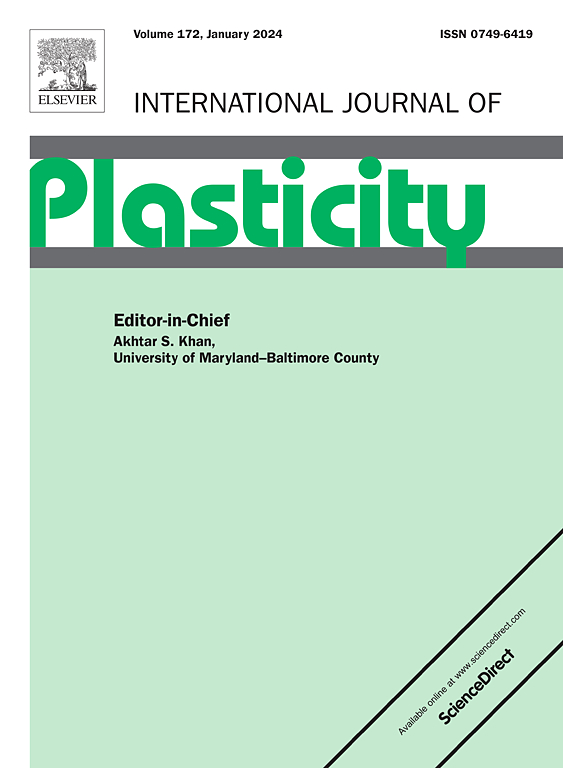添加ti的AlCoCrFeNi2.1高熵合金在中等温度下具有优异的强度和延展性
IF 12.8
1区 材料科学
Q1 ENGINEERING, MECHANICAL
引用次数: 0
摘要
近年来,高熵合金在室温和低温下的优异力学性能引起了人们的广泛关注。然而,它们在中等温度下较差的力学性能阻碍了它们在许多情况下的实际应用。本研究考察了Ti的加入对增材制造的alcocrfeni2中温拉伸性能的影响。共晶高熵合金。结果表明,Ti的加入通过几个重要机制改善了合金的拉伸性能。Ti的加入显著增加了背应力,主导了应变硬化行为。在400℃时,Ti的加入促进了化学长程有序分解和旋量分解的形成,促进了以平面滑移和波状滑移共存为特征的多模位错行为。这增强了加工硬化,从而实现了更好的强度-延展性协同作用。在600°C时,长程有序分解和多轴分解演变为纳米级D03析出物,允许位错钉住,在保持良好延性的同时保持高强度。此外,Ti的加入诱导了一个圆形的双相组织,其中面心立方相作为粘接层,阻止了裂纹沿相边界的扩展。这些机制协同提高了中等温度下的强度和延展性,使ti改性的AlCoCrFeNi₂。1₁高熵合金非常适用于400-600°C温度范围内的应用。本文章由计算机程序翻译,如有差异,请以英文原文为准。


Multiscale chemical ordering heterogeneity facilitates exceptional strength and ductility in additively manufactured Ti-added AlCoCrFeNi2.1 high-entropy alloys at intermediate temperatures
The remarkable mechanical properties of high-entropy alloys at room and cryogenic temperatures have garnered significant attention in recent years. However, their poor mechanical performance at intermediate temperatures has hindered their practical application in many contexts. This study examines the effect of Ti addition on the intermediate-temperature tensile properties of additively manufactured AlCoCrFeNi₂.₁ eutectic high-entropy alloys. The findings demonstrate that Ti addition improves the alloy's tensile properties through several vital mechanisms. Ti addition significantly increases back-stress, which dominates strain-hardening behavior. At 400 °C, Ti addition promotes the formation of chemically long-range ordered and spinodal decomposition, facilitating multi-mode dislocation behavior characterized by coexisting planar and wavy slip. This enhances work-hardening, thereby achieving improved strength-ductility synergy. At 600 °C, the long-range ordered and spinodal decomposition evolved into nanoscale D03 precipitates that allow dislocation pinning and contribute to high strength while preserving good ductility. Moreover, Ti addition induces a rounded dual-phase microstructure, where the face-centered cubic phase serves as an adhesive layer, preventing crack propagation along the phase boundary. These mechanisms synergistically enhance strength and ductility at intermediate temperatures, making Ti-modified AlCoCrFeNi₂.₁ high-entropy alloys highly suitable for applications in the 400–600 °C temperature range.
求助全文
通过发布文献求助,成功后即可免费获取论文全文。
去求助
来源期刊

International Journal of Plasticity
工程技术-材料科学:综合
CiteScore
15.30
自引率
26.50%
发文量
256
审稿时长
46 days
期刊介绍:
International Journal of Plasticity aims to present original research encompassing all facets of plastic deformation, damage, and fracture behavior in both isotropic and anisotropic solids. This includes exploring the thermodynamics of plasticity and fracture, continuum theory, and macroscopic as well as microscopic phenomena.
Topics of interest span the plastic behavior of single crystals and polycrystalline metals, ceramics, rocks, soils, composites, nanocrystalline and microelectronics materials, shape memory alloys, ferroelectric ceramics, thin films, and polymers. Additionally, the journal covers plasticity aspects of failure and fracture mechanics. Contributions involving significant experimental, numerical, or theoretical advancements that enhance the understanding of the plastic behavior of solids are particularly valued. Papers addressing the modeling of finite nonlinear elastic deformation, bearing similarities to the modeling of plastic deformation, are also welcomed.
 求助内容:
求助内容: 应助结果提醒方式:
应助结果提醒方式:


